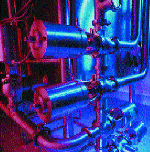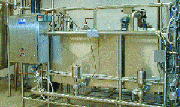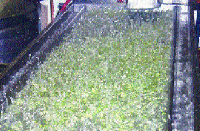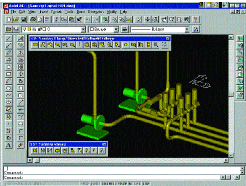
"Manufacturers must adopt a much more holistic view of plant sanitation, from how ingredients are delivered to the shipment of finished goods," said Steve Gray, vice president of business development with Fort Wayne, Ind.-based construction engineering firm Shambaugh & Son. According to Gray,this includes not only rethinking the sanitation of processing systems, but of all the building systems, including electrical fixtures and duct work. A number of improvements in recent years in both automation technology and federal sanitary standards are helping operators develop a plant-wide view of sanitation.
"With the advent of PLC and PC systems that track and store data, there is a greater opportunity to learn what is going on during the sanitation cycle -- particularly with CIP systems -- which helps to manage the process more closely and efficiently," said Gray. For example, new systems measure the temperature, cleaning fluid mix and pressure used in a cleaning session. "If any of the monitored components fail, operators can correct the problem immediately instead of oing ahead with production and then finding the problem," said Gray.

In such plants, manufacturers are placing more emphasis on the employees themselves. "Many companies are transferring sanitation from the third shift to the first or second -- and staffing those shifts with better-trained employees," said John Miller, president of Dublin, Ohio-based engineering consultants Seiberling Associates. According to Miller, HACCP programs place greater emphasis on record keeping and personal accountability, which, in turn, puts greater demand on systems and employees.
Other firms are working to fully automate sanitation systems, eliminating the possibility of human error. "With plants that are manually operated, you are dependent on a sanitation team to be thorough enough each time, but with an automated system it is utterly impossible to deviate from the prescribed cleaning pattern," said Al Worley, technical director with Lake Mills, Wis.-based APV Fluid Handling. APV is currently working to advance automation by creating controls that not only enable operators to monitor the sanitation process, but their daily cost savings as well.

Standard options
Whether by using a fully automated system or a manual one, just how a manufacturer achieves the regulated level of sanitation is his choice.Such leeway is largely the result of the new Sanitation Performance Standards issued by the Food Safety and Inspection Service (FSIS). Instead of a command-and-control approach to sanitation, the standards reflect a more flexible regulatory method based on HACCP philosophy and performance principles. Incorporating FSIS's final rule on sanitation requirements for meat and poultry plants that took effect in January, the standards define the desired sanitation results, but not the specific means to achieve those results.
For example, the standards abolish specific methods for cleaning equipment and utensils. Previously, the standards required that utensils and equipment used to dress diseased meat carcasses be cleaned with either 180 degree F. water or an approved disinfectant. The standards now state "equipment and utensils must be maintained in sanitary condition so as not to adulterate product" (Section 416.3). "The new standards remove obstacles to innovation," said Charles Edwards, director of FSIS's labeling, product and technology standards division. "They allow plants to develop innovative sanitation processing procedures that are the most efficient and best for their unique environments."

Dr. John Partridge, professor of food science and human nutrition at Michigan State University, sees some areas that need to be addressed, specifically by the meat industry, to meet the desired level of sanitation. "While they are not big problems, we've noticed there are fit and finish troubles with equipment that make it difficult to clean either automatically or manually," he said. Partridge specifically cites smoothness of welds and open bearings that would not be acceptable in a dairy plant, but are found in the meat industry.
The American Welding Society recently published a guideline to solve this problem. Released last year at the behest of the 3-A Standard Committee, the Specification for Welding of Austenitic Stainless Steel Tube and Pipe Systems in Sanitary (Hygienic) Applications (D18.1:1999) was developed specifically for food processing and dairy plants by a committee of representatives of the food processing industry and food processing equipment manufacturers. The specifications detail the welding requirements for tubing systems built to 3-A standards, but also apply to meat production.

Something in the air
With the new standards freeing-up manufacturers to develop new methods, many are rethinking their chemical needs. Concern over the use of toxic chemicals in sanitation procedures and the cost associated with their handling and disposal has many owners looking for safer alternatives. Ozone is making strides as a safe alternative and a powerful oxidant that destroys microbes.A form of oxygen, ozone is the third most powerful oxidizer known to man. "In terms of its germ-killing capabilities, ozone has a reaction time that is nearly 3,000 times faster than chlorine and has been used throughout Europe for close to a century," according to Dusty Pearsall, vice president of food systems with West Palm Beach, Fla.-based RGF Environmental Group, an ozone system designer and installer. "Further, it's used as the primary agent of sanitation for more than 80 percent of the bottled water supplied to the U.S."
Prior to the Food Additive Amendment of 1958, evidence shows that ozone was frequently used in food processing sanitation. "Ozone was not included in the Food Additive Amendment simply because no one at that time considered it to be a food chemical, so it was overlooked and did not receive approval," said Dr. Dee Graham, president of Walnut Creek, Calif.-based R & D Enterprises and fellow with the Palo Alto, Calif.-based Electric Power Research Institute. Graham has uncovered evidence of ozone use in meat, egg and other facilities as early as the 1940s, and is working with the USDA and FDA (which rated it Generally Recognized As Safe (GRAS) in 1997) to regain its acceptance and promote its use in the U.S.
Currently, ozone is being used and tracked by the FDA in a growing number of plants around the country as it seeks advanced approval. One of the more prominent uses is in the produce field. At the plant of caramel apple producer Tastee Apple in Newcornerstown, Ohio, aqueous ozone is used both to clean apples and its 6,000-gallon juice storage tanks. Salad maker Sandridge Food Corp. in Medina, Ohio, uses aqueous ozone to disinfect celery and its associated equipment. "We had primarily been using chlorine, but became worried about the fumes. Since installing the ozone last year, we have noticed a positive change," said Ahmad Tahajod, quality assurance manager. Tahajod noted that a lesson learned while fine-tuning the system was that the feed water needs to be as pure as possible before it mixes with the ozone, because the ozone will react with particles in the water, diminishing some of its efficiency.
Late last year, ozone finally re-entered the meat industry. Looking to minimize the need to store and handle hazardous chemical cleaners and sanitizers, Plumrose USA Inc. elected to use ozonated water to sanitize work areas and processing equipment used for slicing and packaging ham, turkey, chicken and deli meats in its Booneville, Miss., plant in October 1999. Recent studies have found that many bacteria such as E. coli, giardia, cryptosporidium, and other new pathogens resist chlorine but are effectively killed by ozone. "Plumrose has had tremendous success with their microbial counts -- which weren't a problem to begin with -- but they were able to continue their good ratings with ozone instead of chlorine," said Graham.
RGF Environmental Group designed and assembled the Plumrose system to produce ozonated water on demand. The system includes an electrical corona generator using a PSA oxygen generator for the feed gas, an injector, contractor tank, distribution pipes and pumps, automated controls, and proprietary application systems designed for the plant. The generator strips nitrogen from the ambient air, creating 98 percent pure oxygen that is used for the feed gas. The system generates 28 grams of ozone per hour and delivers ozonated water to the work areas in closed piping under low pressure. To ensure that the maximum amount of ozone in the air does not exceed the OSHA limit of 0.08 to 0.1 ppm, air quality sensors continually monitor the amount of ozone in the environment.
In addition to using ozone to sanitize plastic storage tubs and stainless-steel walk-in coolers, Plumrose uses ozonated water instead of chlorinated water to rinse its stainless steel transportation racks in a three-part process. Because ozone rapidly decomposes into oxygen, ozonated water from the final rack rinse can be reozonated and used for the first rinse, reducing water usage and disposal costs. Before ozone was installed, a large inventory of 30 percent hypochlorite was kept in locked storage. Throughout the day, 100 ppm chlorine rinses were used on equipment surfaces. Now water containing 1 ppm ozone is used for cleaning equipment. Total cost for the system was $73,800, but has already reduced the $9,000 per quarter Plumrose spends on hypochlorite.

Sidebar: A Sanitary Design
Transforming miles of stainless steel tubing into a performing piping system for food production is an art that has been executed with the same tools for decades. However, designers are often limited to methods intended for the pharmaceutical and petrochemical industries, instead of food. As a result, SSE Software is providing a hardware update with the SSE/Sanitary Piping software module that caters to the piping design needs of the food and beverage industry.The toolbar-based program allows users to automatically insert fittings in the clamp, bevel-seat, TOD, BPE, SMS and weld lines of sanitary tube fittings, hand valves and air valves. Once the part is selected, the user can choose to display in a single, double line 2D or 3D view.
"The software allows us to easily insert industry-specific features into our designs instead of manufacturer-specific," said Richard Lynn, president of PTI Consulting Engineers Inc. of Kansas City, Mo. According to Lynn, that alone has saved his firm roughly 40 percent on time by allowing them to select the manufacturer best-suited to the project.
The Sanitary Piping module works in tandem with CADWorx/PIPE, and features additional modules including a Bill-of-Material and Estimator module. Information and downloads are available from the SSE Software web site at www.ssesoftware.com.